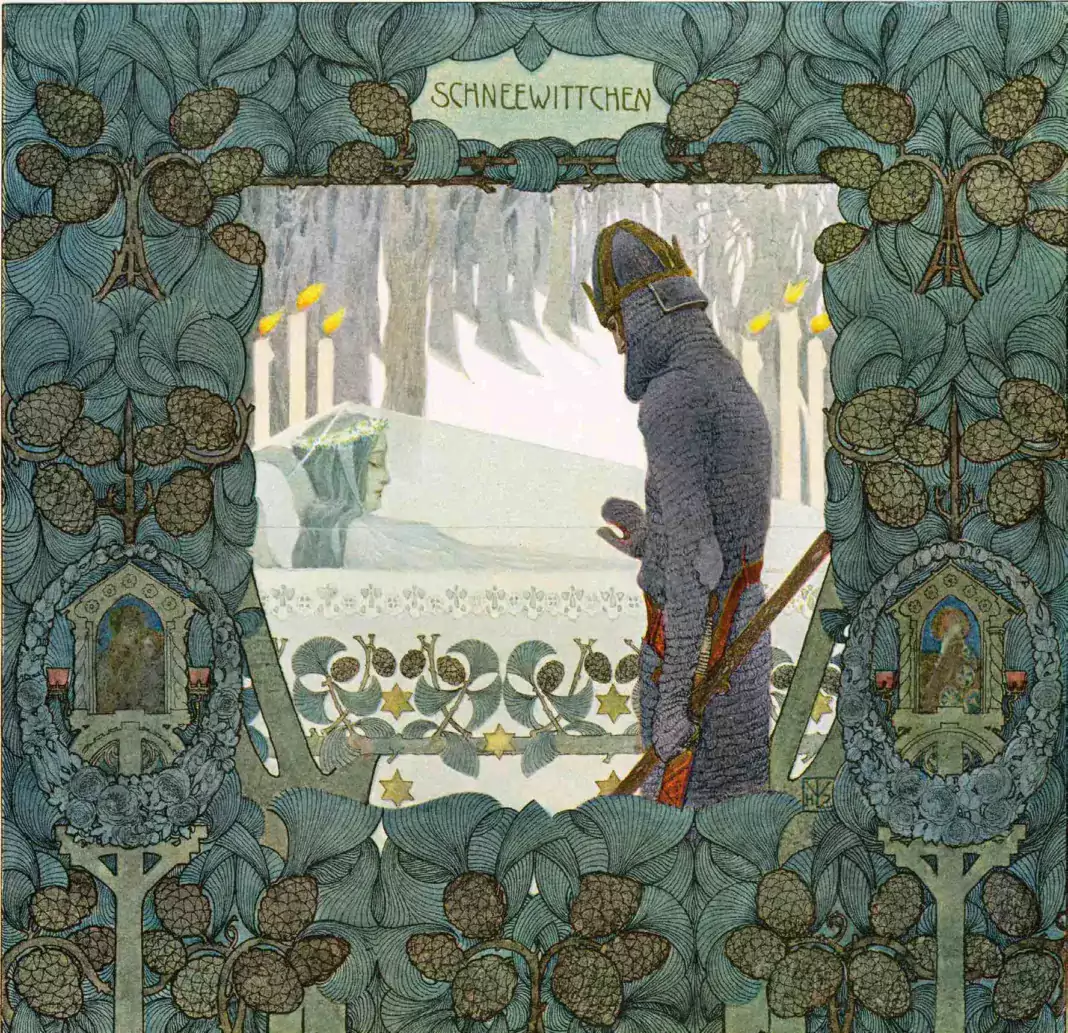Feature Image:
Illustration by Joseph Urban and H. Lefler for Märchen-Kalendar (1905)
A young girl lies in a glass coffin, alone in the woods, her black hair spread across her pillow. Her lips are as red as blood and her skin is as white as snow. She is neither dead nor truly alive. The shadows of the forest creep in closer as you watch her, wondering if she will ever awaken … and what she would do if she did.
Sounds like a passage from a gothic vampire novel, right? It is instead, of course, describing the fairy tale “Snow White,” a story so familiar that most people could tell you the plot without thinking twice. The truth is that fairy tales are often very gothic … and gothic literature frequently draws from fairy tales.
Our traditional fairy tales are a lot scarier than people tend to remember. They’re full of sinister encounters with wolves, dark forests, and fragile mortality. As the scholar Lucie Armitt puts it, “the child-devouring witches and ogres that lurk in the forest are an early introduction to the dangerous possibilities of the (only apparently) familiar, and one has simply to consider the imaginative impact of the house of sweets in ‘Hansel and Gretel’ or Granny’s bedroom in ‘Little Red Riding Hood’ to recognize the abiding presence of gothic motifs, such as the sinister mansion or Bluebeard’s bloody chamber.” To Armitt’s list we’d also add the strikingly vampiric description of Snow White and the death-like enchanted sleep of the princess in “Sleeping Beauty.” Take a look at the following tales with fresh eyes and you’ll see what we mean:
• “Little Snow-White” by Jacob and Wilhelm Grimm
• “Little Briar Rose” by Jacob and Wilhelm Grimm
• “Hansel and Gretel” by Jacob and Wilhelm Grimm
• “Little Red Riding Hood” by Charles Perrault
• “Bluebeard” by Charles Perrault
Now that we’ve established that there are gothic elements in many of the traditional fairy tales you know and love, let’s flip the script and take a look at the 19th century gothic texts that draw from traditional fairy-tale narratives—you might be surprised at how many of them do! Gothic literature was at its height during this time, particularly at the beginning and the end of the century, and fairy tales were hugely popular as well. It makes sense that they would be combined to great effect! Consider classics like:
• Jane Eyre by Charlotte Brontë (“Beauty and the Beast,” “Bluebeard,” “Cinderella”)
• Bleak House by Charles Dickens (“Sleeping Beauty,” “Little Red Riding Hood”) Great Expectations by Charles Dickens (“Sleeping Beauty,” “Cinderella”)
• The Picture of Dorian Gray by Oscar Wilde (“Cinderella,” “Snow White”) Wuthering Heights by Emily Brontë (“Sleeping Beauty,” “Beauty and the Beast”)
One of the most common and recognizable ways that we encounter gothic fairy tales today is through fairy-tale retellings. In other words, an author starts with a pre-existing fairy tale and puts their own unique spin on it, making it their own. Sometimes, that spin is distinctly gothic. The absolute queen of this strategy is Angela Carter, a British writer who published a collection of fairy-tale retellings called The Bloody Chamber in 1979. In these tales, Carter finds the “dread glamour” at the heart of traditional tales and cranks the volume up until they positively shimmer with gothic radiance. The Bloody Chamber changed the way people thought about fairy-tale retellings and the gothic, kicking off a tidal wave of reimagined stories that continues to this day. We recommend:
• The Bloody Chamber by Angela Carter (various tales)
• Heart’s Blood by Juliet Marillier (“Beauty and the Beast”)
• The Shadow in the Glass by Jja Harwood (“Cinderella”)
• The Seventh Bride by T. Kingfisher (“Bluebeard”)
“Snow, Glass, Apples” by Neil Gaiman (“Snow White”)
• “The Maiden-Tree” by Catherynne Valente
(“Sleeping Beauty”)
Lastly, we absolutely love books about books. (We are giant nerds, can you tell?) And our favorites are often gothic books about books of fairy tales. There’s something so indulgent and magical to us about stories that center how books can make us feel—the way they can captivate and hold our attention, the way they carry secrets under their spines. The heroes of these stories are often obsessed with their books of fairy tales, and these books end up changing the course of their lives. And who among us hasn’t had a book change their life?
• The Hazel Wood by Melissa Albert
• The Forgotten Garden by Kate Morton
• The Thirteenth Tale by Diane Setterfield
• In the Night Wood by Dale Bailey
Turn the pages and step through the locked door, into dark forests and forbidden chambers. Hold the dread glamour close to your heart, alongside “once upon a time …”

































